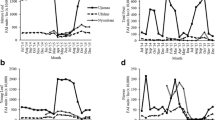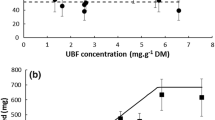Abstract
Exotic species can provide abundant food resources for native consumers, but predicting which native species will respond positively remains a challenge. We studied the foraging behavior of black-capped (Poecile atricapillus) and mountain (P. gambeli) chickadees in western Montana to compare the degree to which these congeric and syntopic consumers exploited larvae of Urophora, an exotic biological control insect living within the seedheads of the invasive forb, spotted knapweed (Centaurea stoebe). Chickadees typically forage within tree or shrub cover, whereas knapweed and hence Urophora larvae thrive in open grassland away from cover. We found that black-capped chickadees were much more likely than mountain chickadees to forage for Urophora. Black-capped chickadees strategically minimized time spent in open habitats by flying out from cover to retrieve knapweed seedheads and immediately returning to cover to extract the larvae. Black-capped chickadees also employed an atypical hovering technique nearly twice as often as their congeners did, particularly when foraging away from cover. Via this hovering technique, birds were able to gather knapweed seedheads from erect plants rather than searching for seedheads on the ground. These shifts in foraging behavior allowed black-capped chickadees to exploit Urophora larvae to a much greater degree than their congeners while minimizing exposure to a high-risk habitat, an outcome with potentially important community-wide consequences. Behavioral flexibility has been used to predict the success of invading species. We suggest that behavioral flexibility may also be used to predict how native species will respond to invasions, particularly the availability of exotic food resources.



Similar content being viewed by others
References
Abrahamson WG, Sattler JF, McCrea KD, Weis AE (1989) Variation in selection pressures on the goldenrod gall fly and the competitive interactions of its natural enemies. Oceologia 79:15–22
Barber NA, Marquis RJ, Tori WP (2008) Invasive prey impacts the abundance and distribution of native predators. Ecology 89:2678–2683
Boutin S (1990) Food supplementation experiments with terrestrial vertebrates: patterns, problems, and the future. Can J Zool 68:203–220
Brittingham MC, Temple SA (1988) Impacts of supplemental feeding on survival rates of black-capped chickadees. Ecology 69:581–589
Desrochers A (1985) Sex determination of black-capped chickadees with a discriminant analysis. J Field Ornithol 61:79–84
Desrochers A (1989) Sex, dominance, and microhabitat use in wintering blackcapped chickadees: a field experiment. Ecology 70:636–664
Desrochers A, Hannon SJ, Nordin KE (1988) Winter survival and territory acquisition in a northern population of black-capped chickadees. Auk 105:727–736
Dial KP (2003) Evolution of avian locomotion: correlates of flight style, locomotor module, nesting biology, body size, development, and the origin of flapping flight. Auk 120:941–952
Foote JR, Mennill DJ, Ratcliffe LM, Smith SM (2010) Black-capped chickadee (Poecile atricapillus) In: Poole A (ed) The Birds of North America Online. Cornell Lab of Ornithology, Ithaca. Retrieved from the Birds of North America Online. doi:10.2173/bna.39. http://bna.birds.cornell.edu/bna/species/039
Fox RA, Ladage LD, Roth TC II, Pravosudov VV (2009) Behavioural profile predicts dominance status in mountain chickadees, Poecile gambeli. Anim Behav 77:1441–1448
Garland T, Adolph SC (1994) Invited perspectives in physiological zoology why not to do two-species comparative studies: limitations on inferring adaptation. Physiol Zool 67:797–828
Grava A, Grava T, Didier R, Lait LA, Dosso J, Koran E, Burg TM, Otter KA (2012) Interspecific dominance relationships and hybridization between black-capped and mountain chickadees. Behav Ecol 23:566–572
Greenberg R (1989) Neophobia, aversion to open space, and ecological plasticity in song and swamp sparrows. Can J Zool 67:1194–1199
Greenberg R (1990) Ecological plasticity, neophobia, and resource use in birds. Stud Avian Biol 13:431–437
Greenberg R, Mettke-Hofmann C (2001) Ecological aspects of neophobia and neophilia in birds. Curr Ornithol 16:119–178
Hill BG, Lein MR (1988) Ecological relations of sympatric black-capped and mountain chickadees in southwestern Alberta. Condor 90:875–884
Holmes RT, Marra PP, Sherry TW (1996) Habitat-specific demography of breeding black-throated blue warblers (Dendroica caerulescens): implications for population dynamics. J Ecol 65:183–195
Holway DA, Suarez AV (1999) Animal behavior: an essential component of invasion biology. Trends Ecol Evol 14:328–330
Lackschewitz K (1991) Vascular plants of west-central Montana. USDA Forest Service, General Technical Report INT-277, Ogden, UT, USA
Lefebvre L, Whittle P, Lascaris E, Finkelstein A (1997) Feeding innovations and forebrain size in birds. Anim Behav 53:549–560
Levine JM, Vila M, D’Antonio CM, Dukes JS, Grigulis K, Lavorel S (2003) Mechanisms underlying the impacts of exotic plant invasions. Proc R Soc Lond 270:775–781
Lima SL (1985) Maximizing feeding efficiency and minimizing time exposed to predators: a trade-off in the black-capped chickadee. Oecologia 66:60–67
Marshall MR, Cooper RJ, DeCecco JA, Strazanac J, Butler L (2002) Effects of experimentally reduced prey abundance on the breeding ecology of the Red-eyed Vireo. Ecol Appl 12:261–280
Martin LB II, Fitzgerald L (2005) A taste for novelty in invading house sparrows, Passer domesticus. Behav Ecol 16:702–707
McCallum AD, Grundel R, Dahlsten DL (1999) Mountain chickadee (Poecile gambeli). In: Poole A (ed) The Birds of North America Online. Cornell Lab of Ornithology, Ithaca. Retrieved from the Birds of North America Online. doi:10.2173/bna.453. http://bna.birds.cornell.edu/bna/species/453
McCusker CE, Ward MP, Brawn JD (2010) Seasonal responses of avian communities to invasive bush honeysuckles (Lonicera spp.). Biol Invasions 12:2459–2470
Metlen K (2010) Using patchy plant invasions to understand how diffuse interactions modify facilitation and competition. Dissertation, University of Montana
Metlen K, Aschehoug ET, Callaway RM (2012) Competitive outcomes between two exotic invaders are modified by direct and indirect effects of a native conifer. Oikos 122:622–640
Mettke-Hofmann C, Winkler H, Hamel PB, Greenberg R (2013) Migratory New World blackbirds (Icterids) are more neophobic than closely related resident Icterids. PLoS One 8(2):e57565
Møller AP (2009) Successful city dwellers: a comparative study of the ecological characteristics of urban birds in the Western Palearctic. Oecologia 159:849–858
Moreno E, Barluenga M, Barbosa A (2001) Ecological plasticity by morphological design reduces costs of subordination: influence on species distribution. Oecologia 128:603–607
Noonburg EG, Byers JE (2005) More harm than good: when invader vulnerability to predators enhances impact on native species. Ecology 86:2555–2560
Ortega YK, Pearson DE, McKelvey KS (2004) Effects of biological control agents and exotic plant invasion on deer mouse populations. Ecol Appl 14:241–253
Ortega YK, McKelvey KS, Six DL (2006) Invasion of an exotic forb impacts reproductive success and site fidelity of a migratory songbird. Oecologia 149:340–351
Ortega YK, Pearson DE, Waller LP, Sturdevant NJ, Maron JL (2012) Population-level compensation impedes biological control of an invasive forb and indirect release of a native grass. Ecology 93:783–792
Pearson DE, Callaway RM (2003) Indirect effects of host-specific biological control agents. Trends Ecol Evol 18:456–461
Pearson DE, Callaway RM (2005) Indirect nontarget effects of host-specific biological control agents: Implications for biological control. Biol Control 35:288–298
Pearson DE, Callaway RM (2006) Biological control agents elevate hantavirus by subsidizing mice. Ecol Lett 9:442–449
Pearson DE, Callaway RM (2008) Weed biocontrol insects reduce native plant recruitment through second order apparent competition. Ecol Appl 18:1489–1500
Pearson DE, Fletcher RJ (2008) Mitigating exotic impacts: restoring deer mouse populations elevated by an exotic food subsidy. Ecol Appl 18:321–334
Pearson DE, McKelvey KS, Ruggiero LF (2000) Non-target effects of an introduced biocontrol agent on deer mouse ecology. Oecologia 122:121–128
Pearson DE, Ortega YK, Sears S (2012) Darwin’s naturalization hypothesis up-close: intermountain grassland invaders differ morphologically and phenologically from native community dominants. Biol Invasions 14:901–913
Pintor LM, Sih A, Bauer ML (2008) Differences in aggression, activity and boldness between native and introduced populations of an invasive crayfish. Oikos 117:1629–1636
Pintor LM, Sih A, Kerby JL (2009) Behavioral correlations provide a mechanism for explaining high invader densities and increased impacts on native prey. Ecology 90:581–587
Pysek P, Jarosik V, Hulme PE, Pergl J, Hejda M, Schaffner U, Villa M (2012) A global assessment of invasive plant impacts on resident species, communities and ecosystems: the interaction of impact measures, invading species’ traits and environment. Glob Change Biol 18:1725–1737
Rehage JS, Sih A (2004) Dispersal behavior, boldness, and the link to invasiveness: a comparison of four Gambusia species. Biol Invasions 6:379–391
Robinson SK, Holmes RT (1982) Foraging behavior of forest birds: the relationships among search tactics, diet, and habitat structure. Ecology 63:1918–1931
Rodriguez LF (2006) Can invasive species facilitate native species? Evidence of how, when, and why these impacts occur. Biol Invasions 8:927–939
Roemer GW, Donlan CJ, Courchamp F (2002) Golden eagles, feral pigs, and insular carnivores: how exotic species turn native predators into prey. PNAS 99:791–796
Salo P, Korpimaki E, Banks PB, Nordstrom M, Dickman CR (2007) Alien predators are more dangerous than native predators to native prey populations. Proc R Acad 274:1237–1243
Samson FB, Lewis SJ (1979) Experiments on population regulation in two North American parids. Wilson Bull 91:222–233
Schneider KJ (1984) Dominance, predation, and optimal foraging in white-throated sparrow flocks. Ecology 65:1820–1827
Schummer ML, Petrie SA, Bailey RC (2008) Dietary overlap of sympatric diving ducks during winter on northeastern Lake Ontario. Auk 125:425–433
Sih A, Bell AM, Johnson JC (2004) Behavioral syndromes: an ecological and evolutionary overview. Trends Ecol Evol 19:372
Sih A, Stamps J, Yang LH, McElreath R, Ramenofsky M (2010) Behavior as a key component of integrative biology in a human altered world. Integr Comp Biol 50:934–944
Sih A, Ferrari MCO, Harris DJ (2011) Evolution and behavioural responses to human-induced rapid environmental change. Evol Appl 4:367–387
Sol D, Timmerman S, Lefebvre L (2002) Behavioural flexibility and invasion success in birds. Anim Behav 63:495–502
Sol D, Duncan RP, Blackburn TM, Cassey P, Lefebvre L (2005a) Big brains, enhanced cognition, and response of birds to novel environments. PNAS 12:5460–5465
Sol D, Lefebvre L, Rodriguez-Teijeiro JD (2005b) Brain size, innovative propensity and migratory behaviour in temperate Palaearctic birds. Proc R Soc B 272:1433–1441
Sol D, Bacher S, Reader SM, Lefebvre L (2008) Brain size predicts the success of mammal species introduced into novel environments. Am Nat 172:S63–S71
Sol D, Griffin AS, Bartomeus I, Boyce H (2011) Exploring or avoiding novel food resources? The novelty conflict in an invasive bird. PLoS One 6:1–7
Story JM, Nowierski RM, Boggs KW (1987) Distribution of Urophora affinis and U. quadrifasciata, two flies introduced for biological control of spotted knapweed (Centaurea maculosa) in Montana. Weed Sci 35:145–148
Story JM, Boggs KW, Good WR, White LJ, Nowierski RM (1995) Cause and extent of predation on Urophora spp. larvae (Diptera: Tephritidae) in spotted knapweed seedheads. Environ Entomol 24:1467–1472
Tablado Z, Tella JL, Sanchez-Zapata J, Hiraldo F (2010) The paradox of the long-term positive effects of a North American crayfish on a European community of predators. Conserv Biol 24:1230–1238
Templeton CN (2011) Black-capped chickadees select spotted knapweed seedheads with high densities of gall fly larvae. Condor 113:395–399
Templeton CN, Greene E, Davis K (2005) Allometry of alarm calls: black-capped chickadees encode information about predator size. Science 308:1934–1937
Waring GH, Loope LL, Medeiros AC (1993) Study on use of alien versus native plants by nectarivorous forest birds on Maui, Hawaii. Auk 110:917–920
Webster SJ, Lefebvre L (2001) Problem solving and neophobia in a columbiform–passeriform assemblage in Barbados. Anim Behav 62:23–32
Acknowledgments
We thank C. Templeton and M. Young for comments on drafts of the manuscript, and L.S. Bagget for statistical guidance. We are grateful to S. Fuller for her hard work in the field. Research was supported by Rocky Mountain Research Station. RMC thanks NSF EPSCoR Track-1 EPS-1101342 (INSTEP 3).
Author information
Authors and Affiliations
Corresponding author
Rights and permissions
About this article
Cite this article
Ortega, Y.K., Greenwood, L.F., Callaway, R.M. et al. Different responses of congeneric consumers to an exotic food resource: who gets the novel resource prize?. Biol Invasions 16, 1757–1767 (2014). https://doi.org/10.1007/s10530-013-0625-6
Received:
Accepted:
Published:
Issue Date:
DOI: https://doi.org/10.1007/s10530-013-0625-6




